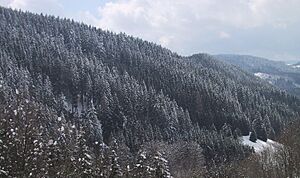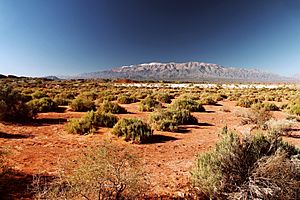Walther Penck facts for kids
Quick facts for kids
Walther Penck
|
|
|---|---|
| Born | 30 August 1888 |
| Died | 29 September 1923 (aged 35) Stuttgart, Germany
|
| Nationality | German |
| Citizenship | Germany |
| Alma mater | Heidelberg University |
| Known for | Landscape evolution theorist |
| Scientific career | |
| Fields | Geomorphology |
| Institutions | Dirección General de Minas University of Constantinople University of Leipzig |
Walther Penck (born August 30, 1888 – died September 29, 1923) was a German geologist. He was also a geomorphologist, which means he studied how Earth's landforms change over time. Penck is famous for his ideas about how landscapes develop.
He believed that landforms change as the land is pushed up (uplift) and worn down by erosion (denudation) at the same time. He thought these processes happen slowly and continuously. His ideas helped change how scientists understood the "cycle of erosion" theory, which was popular at the time.
Contents
Biography

Walther Penck was born in Vienna, a city that was part of Austria-Hungary. His father, Albrecht Penck, was also a famous geographer. Walther studied petrology (the study of rocks) at Heidelberg University and earned his PhD.
From 1912 to 1915, he worked in Buenos Aires, Argentina. Later, he became a professor at the University of Constantinople (now in Turkey). In 1918, he moved to the University of Leipzig in Germany, where he became a professor.
Penck studied landforms in several places. These included the Black Forest in Germany, the Puna de Atacama in Argentina, and parts of modern Turkey. These real-world examples helped him develop his theories.
During the 1920s, Penck and other German scientists disagreed with a theory called the "geographical cycle." This theory was developed by an American scientist named William Morris Davis. Davis often reacted strongly to criticism. He thought Penck didn't fully understand his theory.
Walther Penck sadly died from oral cancer in September 1923. He was only 35 years old. His father published his most important book, Morphological Analysis of Landforms, in 1924 after his death.
Walther Penck's Ideas on Landforms
Walther Penck had some important ideas about how Earth's surface changes. He believed that the way landforms look depends on how fast the land is being pushed up from below.
Key Concepts in Landform Study
Penck used specific terms to describe different landforms:
- Endrumpf: This is a very flat landscape with gentle, curving slopes. It's like the final stage of erosion, after mountains and hills have been worn down.
- Grossfalt: This means "great fold." It describes large folds in the Earth's crust, like how mountains form when rocks are squeezed together.
- Piedmontfläche: This can be thought of as a flat area found at the base of mountains.
- Piedmonttreppen: These are like steps or terraces that go down a mountain. Penck thought these "steps" formed when a large area of land was pushed up, and erosion created these flat levels.
- Primärrumpf: This is a mostly flat, slightly rounded surface. Penck thought that erosion cycles often start from this kind of gentle slope.
How Landforms Change with Uplift
Walther Penck believed that the speed at which land is uplifted (pushed up) affects how landforms develop. He described three main ways landscapes could change, all starting from a relatively flat surface and ending with a very flat one. The differences depended on how fast the land was rising:
- If the land rose very slowly, it would form flat plains called peneplains.
- If the land rose at a medium speed, it would create intermediate forms.
- If the land rose very quickly, it would form steep, Alpine-like mountains.
Penck also thought that the steepness of valley slopes depended on how fast the land was being uplifted. This was different from William Morris Davis's idea, which said that valley steepness depended on how old the valley was.
Types of Land Regions
Penck suggested that the Earth's surface could be divided into three types of regions, each with its own set of landforms:
- Regions where there was a lot of folding and general pushing up of the land.
- Regions where the land was mainly being pushed up in dome shapes.
- Regions where the land was stable and not moving much.


